Many films have used time travel as their plot device, including films you may recognize like Back to The Future (1985), Miss Peregrine’s Home for Peculiar Children (2016), and X-Men: Days of Future’s Past (2014). Television shows such as Futurama, Doctor Who, and The Twilight Zone have also heavily invested in the concept. It’s not a new idea, but every film or show has their hypothesis of how time travel works. The 1963 short film La Jetée, or The Pier in English, directed by Chris Marker, takes us through his creative, original vision of time travel where a man realizes he witnessed his own death. The short film is made solely out of still photographs and narrated by Jean Négroni, whose somber, deep voice adds a ghostly tone to the photomontage.
The key to understanding how brilliant this film is is that Marker created movement and time without using video, thus, editing in the movie plays the lead role in our understanding of the storyline and the cinematic language. The fade-outs and Ken Burns effects create the passage of time presented in the film. Without editing, the photos would be in succession, but there would be no continuity and time progression. It would be like viewing a slide show of when your grandparents went to Honolulu for vacation – they’re beautiful photos, but boring to watch. The photomontage stands out compared to the rest of the films we have looked at already since it is the only one comprised of just still photos. The photographs were taken from a reel of film. Marker used an optical printer, which was a camera hooked up to a projector. The film runs through the projector, and the camera could re-photograph it. The printer allowed SFX artists to do everything a computer could do nowadays by replaying the film frame by frame and modifying the frame’s shape, size, clarity, background, and add on other effects or overlays. The printer didn’t add the products as easy as a computer can, but back in 1962, the optical printer was the leading edge in technology.
In the beginning of the film the narrator explains what the current situation is while music comes from an angelic choir, but instead of sounding heavenly, the music sounds disturbing, like something isn’t right. We are placed in the city of Paris, where a post-nuclear World War III has driven the survivors to underground tunnels where they are barely staying alive. Scientists test experiments (not specified as time travel in the film) on some of the survivors, hoping to perfect their craft so they can go back and prevent the nuclear war from ever happening. There are faint whispers of the scientists discussing. If you watch the film with headphones on, it almost sounds like they are whispering directly into your ear, and it’s very unsettling. Many of the tests were failures and lead to madness or death since their minds and bodies were stripped of the past, present, and future, leaving them in an inescapable limbo.
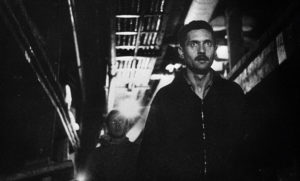
A man (Davos Hanich) that turned to madness after the failed experiment.
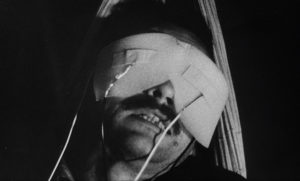
The first man in the experiment.
Parallel to Hiroshima Mon Amour, the two main characters – played by Davos Hanich and Hélène Châtelain – are not given names and in both narratives, names carry with them some possession over the person. If the unnamed woman and man in Hiroshima Mon Amour were given names to begin with, they would have already belonged to something, but by giving each other names at the end, they belonged to each other. On the other hand, in this film, by not giving the characters names, we are distanced from them and emotionless towards the characters’ background. The distance helps bring the focus to the essentialism that the main character in La Jetée faces. When the man appears for the first time in the film, the only sound is his heartbeat along with the narrator’s voice. His heartbeat goes faster or slower according to the stress he is put through. I know a steady heartbeat rhythm can be relaxing for some people, but when paired with the images in the film, the heartbeat is anything but relaxing. The photographs are taken in low-key lighting. The tunnels are already eerie, and when coupled with the low-key lighting, the darkness becomes scarily pitch black. The details of each person’s face are overly emphasized, which generates a daunting feeling and reiterates the ominous environment. The man who first failed the experiment has a face that almost resembles a skull under the low-key lighting. Their clothing in the post-apocalyptic world is relatively standard, but one accessory that is striking to me are the glasses of a scientist. They resemble a mix between Ozzy Osborne glasses and microscope lenses – in other words, the glasses make you feel like the man is being watched closely under a microscope.
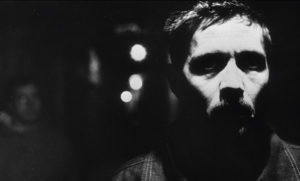
The first man that fails the trial under the low-key lighting.
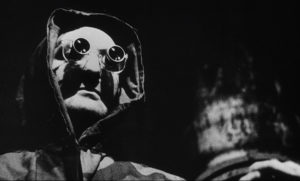
The scientist wears the glasses.
The unnamed man goes on to successfully time travel, but with all the uncertainty he comes across while traveling, the same woman is presented to him every time he travels. After several encounters, he assumes she is dead and won’t find her in the present. There is only one scene where we see the woman move – she is waking up and flutters her eyes. The shot only lasts about a second or two, yet it’s enough to shock the viewer out of the routine stillness. Our minds might have started to wonder what it would be like if this dismal dystopia were real at this point in the film, but the quick flash of movement pulls us out and reminds us that we are alive and real.
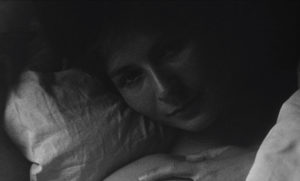
In this shot the woman blinks (although you wouldn’t be able to tell since this is just a photo, but it is the angle that she is looking into the camera from).
As days pass—about 30 days— the man and woman develop a romantic relationship and one day the man travels to a museum filled with animals and meets up with the woman, who has now accepted his strange existence as he mysteriously comes and goes. It is mentioned briefly in the film that the man has a hard time gaining sentience while traveling, until a museum scene where he finally controls his body. They spend the day looking at all of the peculiar animals inside. At one point, all the animals were alive but are now frozen in time, just like the man and woman. There is a photo where they are looking at an animal similar to a large donkey, and it almost seems like their legs match up with the animal’s legs, becoming the exhibit themselves.
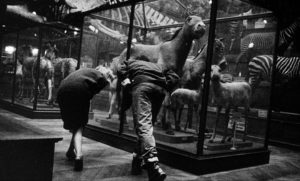
When the couple appears to look like the exhibit.
In most time travel narratives, there is usually a time anomaly and the time anomaly version of the person or thing is always doomed in some way, which leads up to their inevitable death. By the end, the man has mastered traveling into the past and is sent far into the future where a very advanced society gives him what he needs to rebuild Paris. They also offer him an escape, but he chooses to go back to the past and find the woman at the pier. One of the agents follows him and kills him. In his last waking moments, he realized that as a child, the very scenario that had scarred him for most of his life was his death. By going back in time and placing himself in a period where he was not the original, he was doomed from the start.

The man runs to the women in the past on the pier.

The man shot in front of the women by the scientist.
Marker triumphantly conceives a complex narrative and representation of time through the use of just still photos. The spooky environments and distressing sounds are hallowing in every way. However, he also presents the importance of living in the present and not wishing that you could relive the past because there is nothing worth dying for. This film certainly follows suit to all of our other New Wave films; there is a death and a question about mortality, but as each film has had their own take on how to address them—like turning still photos into a time-travel narrative—the movement never fails to keep original ideas flowing.


Recent Comments